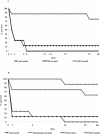Therapeutic activity of an engineered synthetic killer antiidiotypic antibody fragment against experimental mucosal and systemic candidiasis
- PMID: 14573638
- PMCID: PMC219587
- DOI: 10.1128/IAI.71.11.6205-6212.2003
Therapeutic activity of an engineered synthetic killer antiidiotypic antibody fragment against experimental mucosal and systemic candidiasis
Abstract
Peptides derived from the sequence of a single-chain, recombinant, antiidiotypic antibody (IdAb; KT-scFv) acting as a functional internal image of a microbicidal, wide-spectrum yeast killer toxin (KT) were synthesized and studied for their antimicrobial activity by using the KT-susceptible Candida albicans as model organism. A decapeptide containing the first three amino acids (SAS) of the light chain CDR1 was selected and optimized by alanine replacement of a single residue. This peptide exerted a strong candidacidal activity in vitro, with a 50% inhibitory concentration of 0.056 microM, and was therefore designated killer peptide (KP). Its activity was neutralized by laminarin, a beta1-3 glucan molecule, but not by pustulan, a beta1-6 glucan molecule. KP also competed with the binding of a KT-like monoclonal IdAb to germinating cells of the fungus. In a rat model of vaginal candidiasis, local, postchallenge administration of KP was efficacious in rapidly abating infections caused by fluconazole-susceptible or -resistant C. albicans strains. In systemic infection of BALB/c or SCID mice preinfected intravenously with a lethal fungal load, KP caused a highly significant prolongation of the median survival time, with >80% of the animals still surviving after >60 days, whereas >90% of control mice died within 3 to 5 days. KP is therefore the first engineered peptide derived from a recombinant IdAb retaining KT microbicidal activity, probably through the interaction with the beta-glucan KT receptor on target microbial cells.
Figures



References
-
- Alexander, B. D., and J. R. Perfect. 1997. Antifungal resistance trends toward the year 2000. Implications for therapy and new approaches. Drugs 54:657-678. - PubMed
-
- Aliouat, E. M., J. C. Cailliez, N. Sèguy, E. Dei-Cas, L. Polonelli, M. Gerloni, S. Conti, and D. Camus. 1993. Inhibitory effect of a yeast killer toxin to the in vitro Pneumocystis carinii attachment. Serodiagn. Immunother. Infect. Dis. 5:102-106.
-
- Beninati, C. M., R. Oggioni, M. Boccanera, M. R. Spinosa, T. Maggi, S. Conti, W. Magliani, F. De Bernardis, G. Teti, A. Cassone, G. Pozzi, and L. Polonelli. 2000. Therapy of mucosal candidiasis by expression of an antiidiotype in human commensal bacteria. Nat. Biotechnol. 18:1060-1064. - PubMed
-
- Cassone, A., S. Conti, F. De Bernardis, and L. Polonelli. 1997. Antibodies, killer toxins and antifungal immunoprotection: a lesson from nature? Immunol. Today 18:164-169. - PubMed
-
- Cenci, E., A. Mencacci, A. Spreca, C. Montagnoli, A. Bacci, K. Perruccio, A. Velardi, W. Magliani, S. Conti, L. Polonelli, and L. Romani. 2002. Killer antiidiotypes protect from early invasive aspergillosis in a murine model of allogeneic T-cell-depleted bone marrow transplantation. Infect. Immun. 70:2375-2382. - PMC - PubMed
Publication types
MeSH terms
Substances
LinkOut - more resources
Full Text Sources
Other Literature Sources
Medical

